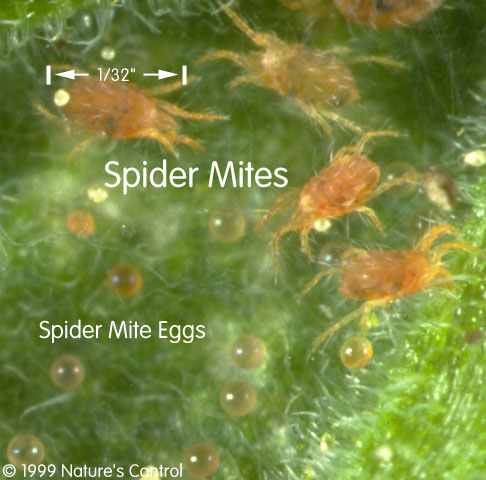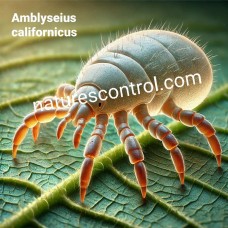Pest: Spider Mites


First Sign: Little yellow speckles on leaf surfaces. When you turn a leaf over, tiny, oval shaped mites, about pin head in size, are scurrying around. Their eggs, best seen with a magnifier, will be scattered around at random. Spider Mite eggs are all perfectly round, the same size, ranging from clear to amber in color. With larger infestations a fine webbing, crawling with mites, covers the plant tops. Soon, the leaves are browning and dying.
Most Common Species: The Two Spot. The "two spot" Spider Mites are usually yellow/tan/greenish in color, and by maturity they grow two dark spots on their shoulders, one on each side. The larger the spots, the older the mite, or the more chlorophyll there is in the plant species they are feeding on. Spider Mites can float along with wind currents, or be carried by pets, clothing or infected plant material.

Special Species Notes: Adult females have the ability to go dormant for a time after the photoperiod (daily hours of light) shortens, then re-emerge to lay more eggs a few weeks after the photoperiod lengthens again. That's one reason Spider Mites keep reappearing crop after crop on indoor plants.
Spider Mite Predators
Spider Mite Predators not only feed on Spider Mites and their eggs, they also breed twice as fast! Each Spider Mite Predator sucks the juice out of about 5 Spider Mites a day, or 20 of their eggs. Used as directed, predators should noticeably begin to gain control within 4 weeks, and then continue until the Spider Mites are nearly or completely wiped out. Predators disappear when the Spider Mites are gone.
Introducing the Ultimate Pest Control Trio: Phytoseiulus persimilis, Neoseiulus californicus, and Amblyseius andersoni
For the most effective pest control, look no further than the Triple Threat! By combining these three species, you can tackle a wide range of growing conditions and ensure comprehensive pest management. Each species comes specialized to address your specific gardening and farming needs. Additionally, we have provided information on pests controlled, recommended environment and conditions, crops, and release instructions for each species.
Predator mites offer several advantages over sprays, other predators, or parasites as biological controls:
Targeted Pest Control: Predator mites specifically target the pest species they are intended to control, such as spider mites. This targeted approach minimizes the impact on beneficial insects and non-target organisms, allowing for selective pest management.
Sustainable and Environmentally Friendly: Predator mites are a natural solution that fits well within integrated pest management (IPM) strategies. They do not leave behind harmful residues or contribute to pesticide resistance, making them an environmentally friendly choice.
Continuous Pest Suppression: Unlike sprays, which provide temporary control, predator mites establish a self-sustaining population that can provide ongoing pest suppression. Once released, they continue to reproduce and feed on pests, maintaining long-term control.
Ability to Reach Hidden Areas: Predator mites can access hard-to-reach areas of the plant, such as the undersides of leaves, where pest populations often reside. This allows for effective control even in challenging environments or dense foliage.
Adaptability and Persistence: Predator mites are adaptable to various environmental conditions and can persist over extended periods, continuously targeting and controlling pests. They can withstand fluctuations in temperature and humidity, ensuring consistent pest management.
Reduced Chemical Inputs: By utilizing predator mites, growers can reduce their reliance on chemical pesticides. This decreases the risks associated with pesticide use, such as chemical residues, environmental contamination, and detrimental effects on beneficial organisms.
Integration with Other Biological Controls: Predator mites can be used in combination with other biological controls, such as parasitic wasps or beneficial nematodes, to create a comprehensive and integrated approach to pest management.
1. Phytoseiulus persimilis:
Pests Controlled: Phytoseiulus persimilis is highly effective in controlling two-spotted spider mites, a common greenhouse and outdoor crop pest. P. persimilis also controls Red spider mites (Tetranychus spp.), Carmine spider mites (Tetranychus cinnabarinus), and Strawberry spider mites (Tetranychus turkestani). Spider mites can cause significant damage to a variety of plants, including fruits, vegetables, and ornamental plants.
Environment and Conditions: Phytoseiulus persimilis thrives in environments with a wide temperature range of 55 - 105+ F and a moderate humidity range of 55 - 90%.
Recommended Crops: This predatory mite is particularly suitable for controlling two-spotted spider mites on greenhouse plants and outdoor crops in mild climates. It can be used on a variety of crops, such as tomatoes, cucumbers, strawberries, and roses.
Release Instructions: To utilize Phytoseiulus persimilis, evenly distribute the mites onto the infested plants. This species is active at room temperature and completes its development cycle, from egg to adult, within 7 days. A well-fed female can lay approximately 50 eggs during her lifetime.
2. Neoseiulus californicus:
Pests Controlled: Neoseiulus californicus is an efficient predator of spider mites, a common pest affecting fruits, vegetables, and ornamental plants. Spider mites cause damage by sucking sap from the leaves, resulting in stunted growth and webbing.
N. californicus controls a variety of pests including:
- Spider mites (Tetranychidae) in general
- Two-spotted spider mites (Tetranychus urticae)
- Carmine spider mites (Tetranychus cinnabarinus)
- Strawberry spider mites (Tetranychus turkestani)
- Rust aka Russet mites (Aceria spp.)
- Broad mites (Polyphagotarsonemus spp.)
Environment and Conditions: This species thrives in environments with a moderate temperature range of 55 - 90 F and a high humidity range of 60 - 90%.
Recommended Crops: Neoseiulus californicus is particularly effective in controlling spider mites on a wide range of crops, including strawberries, peppers, beans, citrus fruits, and roses.
Release Instructions: To utilize Neoseiulus californicus, gently release the mites onto the infested plants. These small mites have a translucent larval stage, and their eggs typically hatch within 1.5 to 4 days, depending on temperature. Females lay 2-4 eggs daily, ensuring a continuous population growth.
3. Amblyseius andersoni:
Pests Controlled: Amblyseius andersoni is a formidable predator against two-spotted spider mites, a common pest in orchards, vineyards, and gardens. These mites cause damage to fruit trees, ornamental plants, and roses. A andersoni controls a wide range of mites and pests including:
- Two-spotted spider mites (Tetranychus urticae)
- Red spider mites (Tetranychus spp.)
- European red mites (Panonychus spp.)
- Pacific spider mites (Tetranychus pacificus)
- Cyclamen mites (Phytonemus pallidus)
- Rust aka Russet mites (Aceria spp.)
- Thrips (Thysanoptera)
- Fungus gnats (Sciaridae)
- Pollen mites (Tydeidae)
Environment and Conditions: Amblyseius andersoni predatory mites are active within the lowest and broadest temperature range from 42 degrees F to 100 degrees F. During periods of low temperatures or short photoperiods (less than 10 hours of light) they will go dormant until conditions change.
Recommended Crops: Amblyseius andersoni is highly effective in controlling two-spotted spider mites on crops such as apples, peaches, pears, cherries, grapes, roses, and other ornamental plants.
Release Instructions: To utilize Amblyseius andersoni, release the predatory mites onto the infested plants. These mites are polyphagous and omnivorous, feeding on various pests, thrips, fungi, and pollen. They remain active even when pests are scarce. Amblyseius andersoni adapts well to diverse environments and temperature ranges.
Remember, you can use each species individually or in combination to achieve the best results. If you don't specify your preference, our Triple Threat mix, including all three species, will be provided to ensure comprehensive pest control.
These tiny Mite Destroyers eat all stages of Spider Mites, and find new infestation sites on their own by flying. But, it takes 4-6 weeks to really get these guys going, so use Predator Mites as well for more immediate control and for cleaning up small "trouble spots". Life cycle takes 18 days at 70 F. 100 Spider Mite Destroyers gets a colony started.
Other Controls: Some customers report good results against Mites with some of our more All-Purpose Predators such as Pirate Bugs, Ladybugs and Green Lacewings , but these results may be due to very specific combinations of conditions that most growing environments don't have. But, if you have these other predators on hand for other plant problems, give them a try if you see Spider Mites.
Handy Hint: Many Pyrethryn sprays are encapsulated. While Pyrethryn is relatively safe (it breaks down quickly), encapsulation can make it last for weeks or months indoors. This residual action kills off Hired Bugs even after it no longer affects pests.
"Triple Threat" Spider Mite Predators
Introducing the Ultimate Pest Control Trio: Phytoseiulus persimilis, Neoseiulus californicus, and Am..
Amblyseius andersoni (Typhlodromus (Amblyseius) potentillae and Amblyseius (Euseius) andersoni)
Amblyseius andersoni (Typhlodromus (Amblyseius) potentillae & Amblyseius (Euseius) anderson..
Amblyseius californicus
Amblyseius californicus (Western predatory mite or the Californian predatory mite): Nature's Solutio..
Amblyseius swirskii
Amblyseius swirskii (controls Spider Mites, Russet Mites, Broad Mites, Thrips, and Whitefl..
Anystis baccarum (Crazee Mite) Units of 1000
Introducing Anystis baccarum (Crazee Mite) - Your Ultimate Biological Pest Control Solution &nb..
Anystis baccarum (Crazee Mite) Units of 250
Introducing Anystis baccarum (Crazee Mite) - Your Ultimate Biological Pest Control Solution &nb..
Anystis baccarum (Crazee Mite) Units of 50
Introducing Anystis baccarum (Crazee Mite) - Your Ultimate Biological Pest Control Solution &nb..
Mammoth Canncontrol
Mammoth Canncontrol is lab and greenhouse tested – proven to eliminate powdery mildew, botrytis..
Ladybugs (Hippodamia convergens)
Ladybugs: Natural and Most Effective Aphid Control Solution Nature's Control is your trusted source..
Spider Mite Destroyers (Stethorus punctillum)
Spider Mite Destroyers (Stethorus punctillum) If Spider Mite Population is Especially Hig..
Pirate Bugs (Orius insidiosis)
Minute Pirate Bugs (Orius insidiosis): Mainly for use against Thrips, Aphids&nb..
Green Lacewing Larvae Eggs (Chrysoperla carnea) Eggs on Cards
Green Lacewing Larvae Eggs: For use against Aphids, Thrips, Mealybugs ..
Green Lacewing Larvae (Chrysoperla carnea) "Ready to Go" Larvae
Green Lacewing Larvae "Ready to Go" Larvae: For use against Aphids, Thrips..
Thrips Predators (Amblyseius cucumeris)
For Control in High Humidity Conditions: Thrips Predator Mites &nb..
Thrips Predators (Amblyseius cucumeris) Units of 50,000
For Thrip Control in High Humidity Conditions: Thrips Predator Mites Units of ..












